Jintao Wang
Model-Driven Deep Learning Enhanced Joint Beamforming and Mode Switching for RDARS-Aided MIMO Systems
Aug 01, 2025Abstract:Reconfigurable distributed antenna and reflecting surface (RDARS) is a promising architecture for future sixth-generation (6G) wireless networks. In particular, the dynamic working mode configuration for the RDARS-aided system brings an extra selection gain compared to the existing reconfigurable intelligent surface (RIS)-aided system and distributed antenna system (DAS). In this paper, we consider the RDARS-aided downlink multiple-input multiple-output (MIMO) system and aim to maximize the weighted sum rate (WSR) by jointly optimizing the beamforming matrices at the based station (BS) and RDARS, as well as mode switching matrix at RDARS. The optimization problem is challenging to be solved due to the non-convex objective function and mixed integer binary constraint. To this end, a penalty term-based weight minimum mean square error (PWM) algorithm is proposed by integrating the majorization-minimization (MM) and weight minimum mean square error (WMMSE) methods. To further escape the local optimum point in the PWM algorithm, a model-driven DL method is integrated into this algorithm, where the key variables related to the convergence of PWM algorithm are trained to accelerate the convergence speed and improve the system performance. Simulation results are provided to show that the PWM-based beamforming network (PWM-BFNet) can reduce the number of iterations by half and achieve performance improvements of 26.53% and 103.2% at the scenarios of high total transmit power and a large number of RDARS transmit elements (TEs), respectively.
Beamforming-Codebook-Aware Channel Knowledge Map Construction for Multi-Antenna Systems
May 22, 2025Abstract:Channel knowledge map (CKM) has emerged as a crucial technology for next-generation communication, enabling the construction of high-fidelity mappings between spatial environments and channel parameters via electromagnetic information analysis. Traditional CKM construction methods like ray tracing are computationally intensive. Recent studies utilizing neural networks (NNs) have achieved efficient CKM generation with reduced computational complexity and real-time processing capabilities. Nevertheless, existing research predominantly focuses on single-antenna systems, failing to address the beamforming requirements inherent to MIMO configurations. Given that appropriate precoding vector selection in MIMO systems can substantially enhance user communication rates, this paper presents a TransUNet-based framework for constructing CKM, which effectively incorporates discrete Fourier transform (DFT) precoding vectors. The proposed architecture combines a UNet backbone for multiscale feature extraction with a Transformer module to capture global dependencies among encoded linear vectors. Experimental results demonstrate that the proposed method outperforms state-of-the-art (SOTA) deep learning (DL) approaches, yielding a 17\% improvement in RMSE compared to RadioWNet. The code is publicly accessible at https://github.com/github-whh/TransUNet.
HoloDx: Knowledge- and Data-Driven Multimodal Diagnosis of Alzheimer's Disease
Apr 27, 2025



Abstract:Accurate diagnosis of Alzheimer's disease (AD) requires effectively integrating multimodal data and clinical expertise. However, existing methods often struggle to fully utilize multimodal information and lack structured mechanisms to incorporate dynamic domain knowledge. To address these limitations, we propose HoloDx, a knowledge- and data-driven framework that enhances AD diagnosis by aligning domain knowledge with multimodal clinical data. HoloDx incorporates a knowledge injection module with a knowledge-aware gated cross-attention, allowing the model to dynamically integrate domain-specific insights from both large language models (LLMs) and clinical expertise. Also, a memory injection module with a designed prototypical memory attention enables the model to retain and retrieve subject-specific information, ensuring consistency in decision-making. By jointly leveraging these mechanisms, HoloDx enhances interpretability, improves robustness, and effectively aligns prior knowledge with current subject data. Evaluations on five AD datasets demonstrate that HoloDx outperforms state-of-the-art methods, achieving superior diagnostic accuracy and strong generalization across diverse cohorts. The source code will be released upon publication acceptance.
Lightweight and Self-Evolving Channel Twinning: An Ensemble DMD-Assisted Approach
Apr 23, 2025



Abstract:Traditional channel acquisition faces significant limitations due to ideal model assumptions and scalability challenges. A novel environment-aware paradigm, known as channel twinning, tackles these issues by constructing radio propagation environment semantics using a data-driven approach. In the spotlight of channel twinning technology, a radio map is recognized as an effective region-specific model for learning the spatial distribution of channel information. However, most studies focus on static channel map construction, with only a few collecting numerous channel samples and using deep learning for radio map prediction. In this paper, we develop a novel dynamic radio map twinning framework with a substantially small dataset. Specifically, we present an innovative approach that employs dynamic mode decomposition (DMD) to model the evolution of the dynamic channel gain map as a dynamical system. We first interpret dynamic channel gain maps as spatio-temporal video stream data. The coarse-grained and fine-grained evolving modes are extracted from the stream data using a new ensemble DMD (Ens-DMD) algorithm. To mitigate the impact of noisy data, we design a median-based threshold mask technique to filter the noise artifacts of the twin maps. With the proposed DMD-based radio map twinning framework, numerical results are provided to demonstrate the low-complexity reproduction and evolution of the channel gain maps. Furthermore, we consider four radio map twin performance metrics to confirm the superiority of our framework compared to the baselines.
Reconfigurable Codebook-Based Beamforming for RDARS-Aided mmWave MU-MIMO Systems
Apr 02, 2025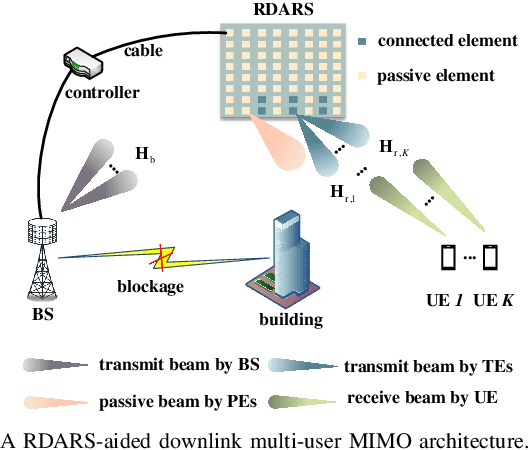
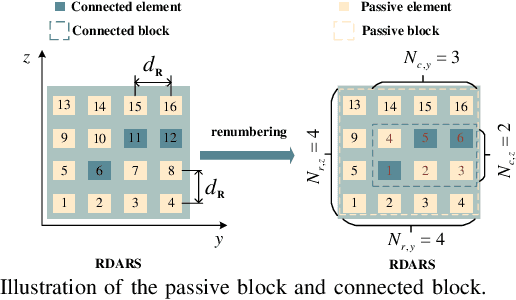

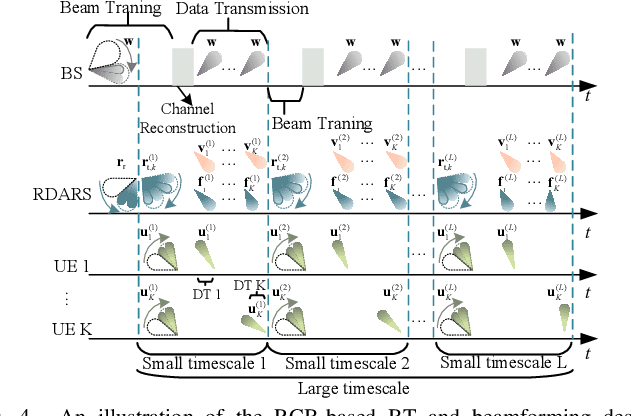
Abstract:Reconfigurable distributed antenna and reflecting surface (RDARS) is a new architecture for the sixth-generation (6G) millimeter wave (mmWave) communications. In RDARS-aided mmWave systems, the active and passive beamforming design and working mode configuration for reconfigurable elements are crucial for system performance. In this paper, we aim to maximize the weighted sum rate (WSR) in the RDARS-aided mmWave system. To take advantage of RDARS, we first design a reconfigurable codebook (RCB) in which the number and dimension of the codeword can be flexibly adjusted. Then, a low overhead beam training scheme based on hierarchical search is proposed. Accordingly, the active and passive beamforming for data transmission is designed to achieve the maximum WSR for both space-division multiple access (SDMA) and time-division multiple access (TDMA) schemes. For the TDMA scheme, the optimal number of RDARS transmit elements and the allocated power budget for WSR maximization are derived in closed form. Besides, the superiority of the RDARS is verified and the conditions under which RDARS outperforms RIS and DAS are given. For the SDMA scheme, we characterize the relationship between the number of RDARS connected elements and the user distribution, followed by the derivation of the optimal placement positions of the RDARS transmit elements. High-quality beamforming design solutions are derived to minimize the inter-user interference (IUI) at the base station and RDARS side respectively, which nearly leads to the maximal WSR. Finally, simulation results confirm our theoretical findings and the superiority of the proposed schemes.
Power Allocation for Coordinated Multi-Point Aided ISAC Systems
Mar 10, 2025Abstract:In this letter, we investigate a coordinated multiple point (CoMP)-aided integrated sensing and communication (ISAC) system that supports multiple users and targets. Multiple base stations (BSs) employ a coordinated power allocation strategy to serve their associated single-antenna communication users (CUs) while utilizing the echo signals for joint radar target (RT) detection. The probability of detection (PoD) of the CoMP-ISAC system is then proposed for assessing the sensing performance. To maximize the sum rate while ensuring the PoD for each RT and adhering to the total transmit power budget across all BSs, we introduce an efficient power allocation strategy. Finally, simulation results are provided to validate the analytical findings, demonstrating that the proposed power allocation scheme effectively enhances the sum rate while satisfying the sensing requirements.
Secure Communication in Dynamic RDARS-Driven Systems
Jan 18, 2025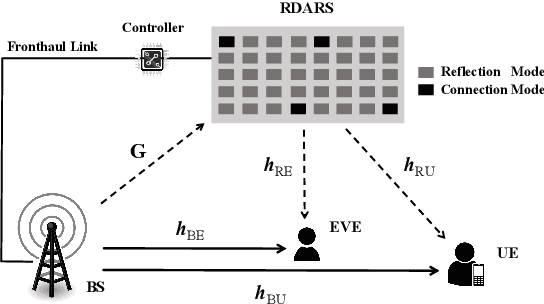
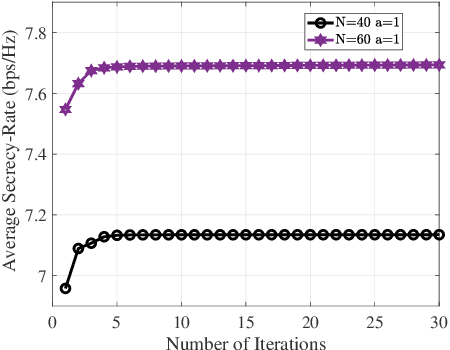

Abstract:In this letter, we investigate a dynamic reconfigurable distributed antenna and reflection surface (RDARS)-driven secure communication system, where the working mode of the RDARS can be flexibly configured. We aim to maximize the secrecy rate by jointly designing the active beamforming vectors, reflection coefficients, and the channel-aware mode selection matrix. To address the non-convex binary and cardinality constraints introduced by dynamic mode selection, we propose an efficient alternating optimization (AO) framework that employs penalty-based fractional programming (FP) and successive convex approximation (SCA) transformations. Simulation results demonstrate the potential of RDARS in enhancing the secrecy rate and show its superiority compared to existing reflection surface-based schemes.
Age Optimal Sampling for Unreliable Channels under Unknown Channel Statistics
Dec 24, 2024Abstract:In this paper, we study a system in which a sensor forwards status updates to a receiver through an error-prone channel, while the receiver sends the transmission results back to the sensor via a reliable channel. Both channels are subject to random delays. To evaluate the timeliness of the status information at the receiver, we use the Age of Information (AoI) metric. The objective is to design a sampling policy that minimizes the expected time-average AoI, even when the channel statistics (e.g., delay distributions) are unknown. We first review the threshold structure of the optimal offline policy under known channel statistics and then reformulate the design of the online algorithm as a stochastic approximation problem. We propose a Robbins-Monro algorithm to solve this problem and demonstrate that the optimal threshold can be approximated almost surely. Moreover, we prove that the cumulative AoI regret of the online algorithm increases with rate $\mathcal{O}(\ln K)$, where $K$ is the number of successful transmissions. In addition, our algorithm is shown to be minimax order optimal, in the sense that for any online learning algorithm, the cumulative AoI regret up to the $K$-th successful transmissions grows with the rate at least $\Omega(\ln K)$ in the worst case delay distribution. Finally, we improve the stability of the proposed online learning algorithm through a momentum-based stochastic gradient descent algorithm. Simulation results validate the performance of our proposed algorithm.
Universal Modem Generation with Inherent Adaptability to Variant Underwater Acoustic Channels: a Data-Driven Perspective
Sep 21, 2024



Abstract:In underwater acoustic (UWA) communication, orthogonal frequency division multiplexing (OFDM) is commonly employed to mitigate the inter-symbol interference (ISI) caused by delay spread. However, path-specific Doppler effects in UWA channels could result in significant inter-carrier interference (ICI) in the OFDM system. To address this problem, we introduce a multi-resolution convolutional neural network (CNN) named UWAModNet in this paper, designed to optimize the modem structure, specifically modulation and demodulation matrices. Based on a trade-off between the minimum and the average equivalent sub-channel rate, we propose an optimization criterion suitable to evaluate the performance of our learned modem. Additionally, a two-stage training strategy is developed to achieve quasi-optimal results. Simulations indicate that the learned modem outperforms zero-padded OFDM (ZP-OFDM) in terms of equivalent sub-channel rate and bit error rate, even under more severe Doppler effects during testing compared to training.
Channel Twinning: An Enabler for Next-Generation Ubiquitous Wireless Connectivity
Jun 18, 2024



Abstract:The emerging concept of channel twinning (CT) has great potential to become a key enabler of ubiquitous connectivity in next-generation (xG) wireless systems. By fusing multimodal sensor data, CT advocates a high-fidelity and low-overhead channel acquisition paradigm, which is promising to provide accurate channel prediction in cross-domain and high-mobility scenarios of ubiquitous xG networks. However, the current literature lacks a universal CT architecture to address the challenges of heterogeneous scenarios, data, and resources in xG networks, which hinders the widespread deployment and applications of CT. This article discusses a new modularized CT architecture to bridge the barriers to scene recognition, cooperative sensing, and decentralized training. Based on the modularized design of CT, universal channel modeling, multimodal cooperative sensing, and lightweight twin modeling are described. Moreover, this article provides a concise definition, technical features, and case studies of CT, followed by potential applications of CT-empowered ubiquitous connectivity and some issues requiring future investigations.
 Add to Chrome
Add to Chrome Add to Firefox
Add to Firefox Add to Edge
Add to Edge